
PBF Energy (NYSE: PBF) & PBF Logistics (NYSE: PBFX) Wells Fargo Energy Symposium December 2014

2 Safe Harbor Statements This presentation contains forward-looking statements made by PBF Energy Inc. and PBF Logistics LP (together, the “Companies”, or “PBF” or “PBFX”) and their management teams. Such statements are based on current expectations, forecasts and projections, including, but not limited to, anticipated financial and operating results, plans, objectives, expectations and intentions that are not historical in nature. Forward-looking statements should not be read as a guarantee of future performance or results, and may not necessarily be accurate indications of the times at, or by which, such performance or results will be achieved. Forward-looking statements are based on information available at the time, and are subject to various risks and uncertainties that could cause the Companies’ actual performance or results to differ materially from those expressed in such statements. Factors that could impact such differences include, but are not limited to, changes in general economic conditions; volatility of crude oil and other feedstock prices; fluctuations in the prices of refined products; the impact of disruptions to crude or feedstock supply to any of our refineries, including disruptions due to problems with third party logistics infrastructure; effects of litigation and government investigations; the timing and announcement of any potential acquisitions and subsequent impact of any future acquisitions on our capital structure, financial condition or results of operations; changes or proposed changes in laws or regulations or differing interpretations or enforcement thereof affecting our business or industry, including any lifting by the federal government of the restrictions on exporting U.S. crude oil; actions taken or non-performance by third parties, including suppliers, contractors, operators, transporters and customers; adequacy, availability and cost of capital; work stoppages or other labor interruptions; operating hazards, natural disasters, weather-related delays, casualty losses and other matters beyond our control; inability to complete capital expenditures, or construction projects that exceed anticipated or budgeted amounts; inability to successfully integrate acquired refineries or other acquired businesses or operations; effects of existing and future laws and governmental regulations, including environmental, health and safety regulations; and, various other factors. Forward-looking statements reflect information, facts and circumstances only as of the date they are made. The Companies assume no responsibility or obligation to update forward-looking statements to reflect actual results, changes in assumptions or changes in other factors affecting forward-looking information after such date.
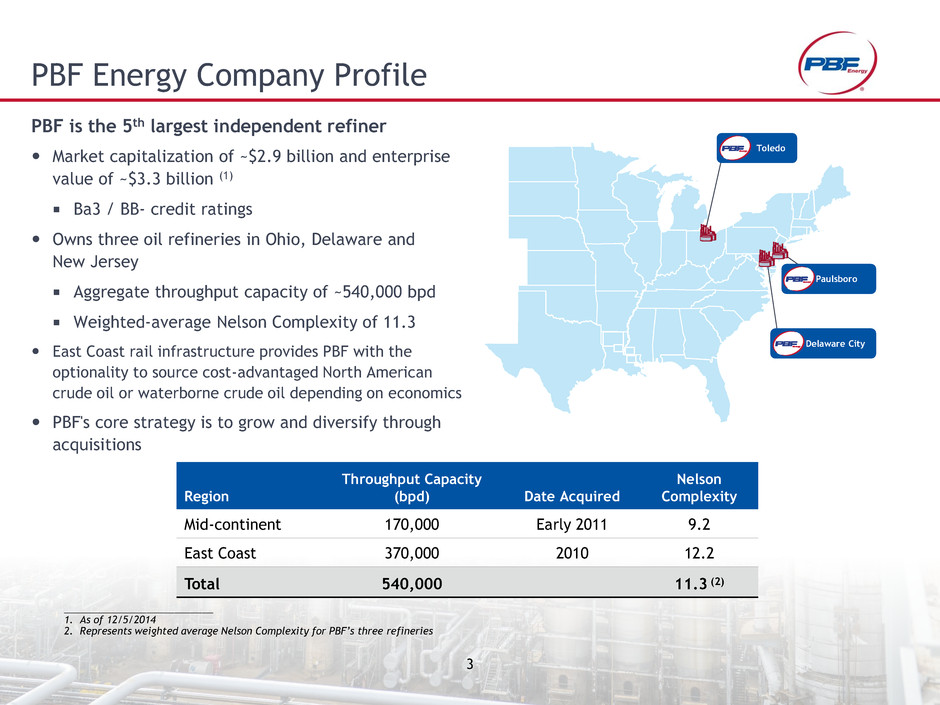
3 PBF Energy Company Profile Market capitalization of ~$2.9 billion and enterprise value of ~$3.3 billion (1) Ba3 / BB- credit ratings Owns three oil refineries in Ohio, Delaware and New Jersey Aggregate throughput capacity of ~540,000 bpd Weighted-average Nelson Complexity of 11.3 East Coast rail infrastructure provides PBF with the optionality to source cost-advantaged North American crude oil or waterborne crude oil depending on economics PBF's core strategy is to grow and diversify through acquisitions Region Throughput Capacity (bpd) Date Acquired Nelson Complexity Mid-continent 170,000 Early 2011 9.2 East Coast 370,000 2010 12.2 Total 540,000 11.3 (2) ___________________________ 1. As of 12/5/2014 2. Represents weighted average Nelson Complexity for PBF’s three refineries Paulsboro Delaware City Toledo PBF is the 5th largest independent refiner
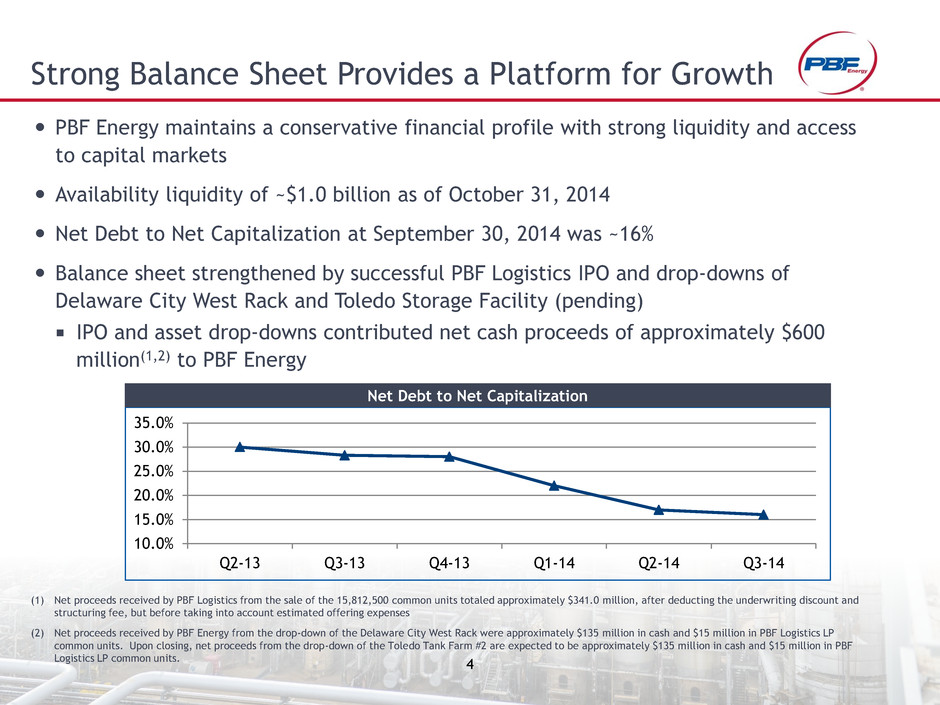
4 PBF Energy maintains a conservative financial profile with strong liquidity and access to capital markets Availability liquidity of ~$1.0 billion as of October 31, 2014 Net Debt to Net Capitalization at September 30, 2014 was ~16% Balance sheet strengthened by successful PBF Logistics IPO and drop-downs of Delaware City West Rack and Toledo Storage Facility (pending) IPO and asset drop-downs contributed net cash proceeds of approximately $600 million(1,2) to PBF Energy Strong Balance Sheet Provides a Platform for Growth (1) Net proceeds received by PBF Logistics from the sale of the 15,812,500 common units totaled approximately $341.0 million, after deducting the underwriting discount and structuring fee, but before taking into account estimated offering expenses (2) Net proceeds received by PBF Energy from the drop-down of the Delaware City West Rack were approximately $135 million in cash and $15 million in PBF Logistics LP common units. Upon closing, net proceeds from the drop-down of the Toledo Tank Farm #2 are expected to be approximately $135 million in cash and $15 million in PBF Logistics LP common units. 10.0% 15.0% 20.0% 25.0% 30.0% 35.0% Q2-13 Q3-13 Q4-13 Q1-14 Q2-14 Q3-14 Net Debt to Net Capitalization

5 - 1,000 2,000 3,000 4,000 5,000 6,000 7,000 2Q14 4Q14 4Q15 Coiled & Insulated General Purpose PBF’s Crude-by-Rail Program Planned Leased or Owned Railcars Note: Schedule is subject to change based on current company plans and on current third party railcar manufacturer delivery schedules PBF’s crude-by-rail program provides PBF Energy with the flexibility to source either rail-delivered crude oil or waterborne crude oil depending on economics East Coast access to cost-advantaged North American crude oil provides optionality ~130,000 bpd PBFX-owned light crude oil unloading facility ~40,000 bpd PBFX-owned heavy crude oil unloading capacity through the “West Rack” ~40,000 bpd PBF-owned heavy crude oil unloading capacity through the “East Rack” 5,900 4,592 3,479 PBF and PBFX will lead the way on rail safety All crude oil delivered to East Coast rail facilities is transported in the new-style DOT-111A rail cars PBF supports increased efforts to enhance the safety of rail operations through the use of a modernized rail fleet, improved operating standards, increased rail inspection and maintenance activities to ensure the safe transport of all crude oil and products

6 U.S. Refining Industry Landscape Inexpensive Natural Gas Growth in supply driving decline in U.S. natural gas pricing U.S. natural gas, 2014 year-to-date, prices almost 50% below European natural gas North American Crude Oil Production Secular growth in North American crude oil production Favorable price dislocations between North American crude and rest of world under current market conditions Complex Refineries Higher complexity than Atlantic Basin competition U.S. average refinery Nelson Complexity of 10.8 versus Western European average refinery Nelson Complexity of 7.8
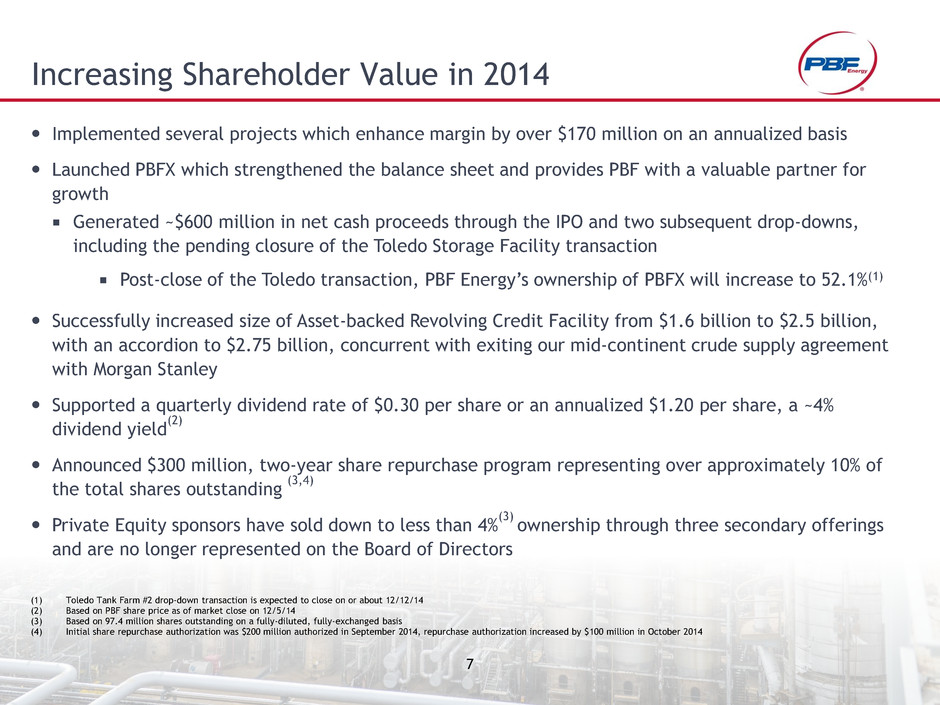
7 Increasing Shareholder Value in 2014 Implemented several projects which enhance margin by over $170 million on an annualized basis Launched PBFX which strengthened the balance sheet and provides PBF with a valuable partner for growth Generated ~$600 million in net cash proceeds through the IPO and two subsequent drop-downs, including the pending closure of the Toledo Storage Facility transaction Post-close of the Toledo transaction, PBF Energy’s ownership of PBFX will increase to 52.1%(1) Successfully increased size of Asset-backed Revolving Credit Facility from $1.6 billion to $2.5 billion, with an accordion to $2.75 billion, concurrent with exiting our mid-continent crude supply agreement with Morgan Stanley Supported a quarterly dividend rate of $0.30 per share or an annualized $1.20 per share, a ~4% dividend yield (2) Announced $300 million, two-year share repurchase program representing over approximately 10% of the total shares outstanding (3,4) Private Equity sponsors have sold down to less than 4% (3) ownership through three secondary offerings and are no longer represented on the Board of Directors (1) Toledo Tank Farm #2 drop-down transaction is expected to close on or about 12/12/14 (2) Based on PBF share price as of market close on 12/5/14 (3) Based on 97.4 million shares outstanding on a fully-diluted, fully-exchanged basis (4) Initial share repurchase authorization was $200 million authorized in September 2014, repurchase authorization increased by $100 million in October 2014

8 PBF Logistics launched in May 2014 Market Cap of ~$800 million as of 12/5/14 PBF Energy owns 52.1%(1) of PBFX, 100% of the GP and IDRs Assets consist of a light crude oil rail unloading terminal in Delaware (“Loop Track”), a heavy crude unloading terminal in Delaware (“West Rack”), a crude oil truck unloading terminal in Toledo and Toledo Tank Farm #2 Loop Track capacity of ~130,000 bpd West Rack capacity of ~40,000 bpd Truck terminal current capacity of ~15,000 bpd Toledo Tank Farm #2 capacity of 3.9 million barrels of crude oil and product storage Significant portfolio of logistics assets retained at PBF that support refinery operations Further information can be found in PBF Logistic’s SEC filings located at www.pbflogistics.com or on the SEC website PBF Logistics LP Company Profile (1) Includes the effect of the increased ownership of PBF Energy as a result of the sale of the Toledo Tank Farm #2 and the expected receipt of proceeds of $135 million in cash and $15 million of PBF Common Units upon closing of the transaction which is expected to be on or about 12/12/14
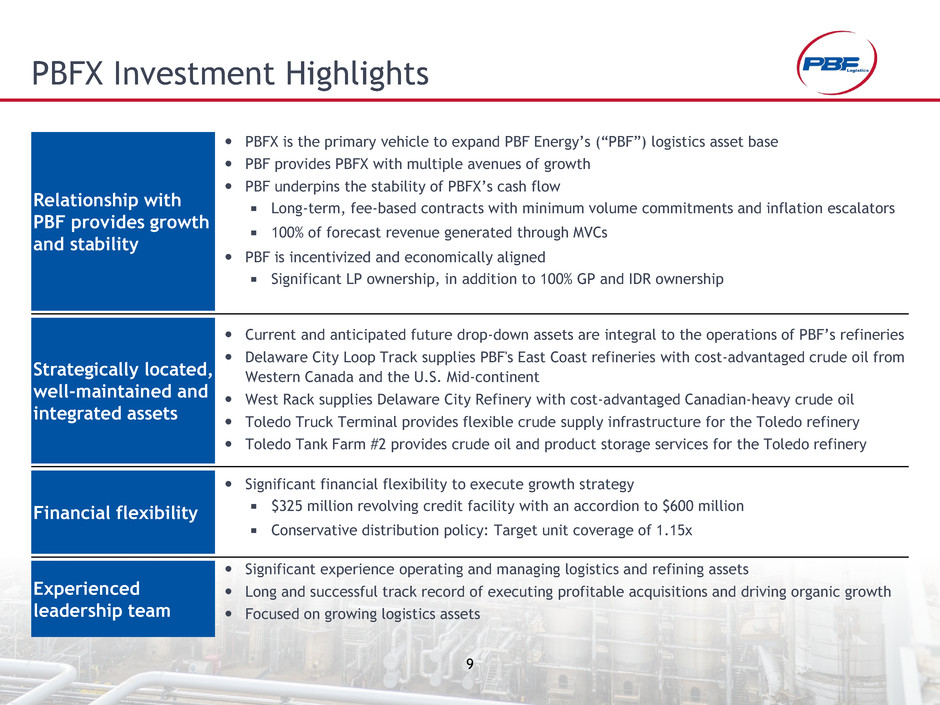
9 PBFX Investment Highlights PBFX is the primary vehicle to expand PBF Energy’s (“PBF”) logistics asset base PBF provides PBFX with multiple avenues of growth PBF underpins the stability of PBFX’s cash flow Long-term, fee-based contracts with minimum volume commitments and inflation escalators 100% of forecast revenue generated through MVCs PBF is incentivized and economically aligned Significant LP ownership, in addition to 100% GP and IDR ownership Strategically located, well-maintained and integrated assets Current and anticipated future drop-down assets are integral to the operations of PBF’s refineries Delaware City Loop Track supplies PBF's East Coast refineries with cost-advantaged crude oil from Western Canada and the U.S. Mid-continent West Rack supplies Delaware City Refinery with cost-advantaged Canadian-heavy crude oil Toledo Truck Terminal provides flexible crude supply infrastructure for the Toledo refinery Toledo Tank Farm #2 provides crude oil and product storage services for the Toledo refinery Financial flexibility Significant financial flexibility to execute growth strategy $325 million revolving credit facility with an accordion to $600 million Conservative distribution policy: Target unit coverage of 1.15x Experienced leadership team Significant experience operating and managing logistics and refining assets Long and successful track record of executing profitable acquisitions and driving organic growth Focused on growing logistics assets Relationship with PBF provides growth and stability
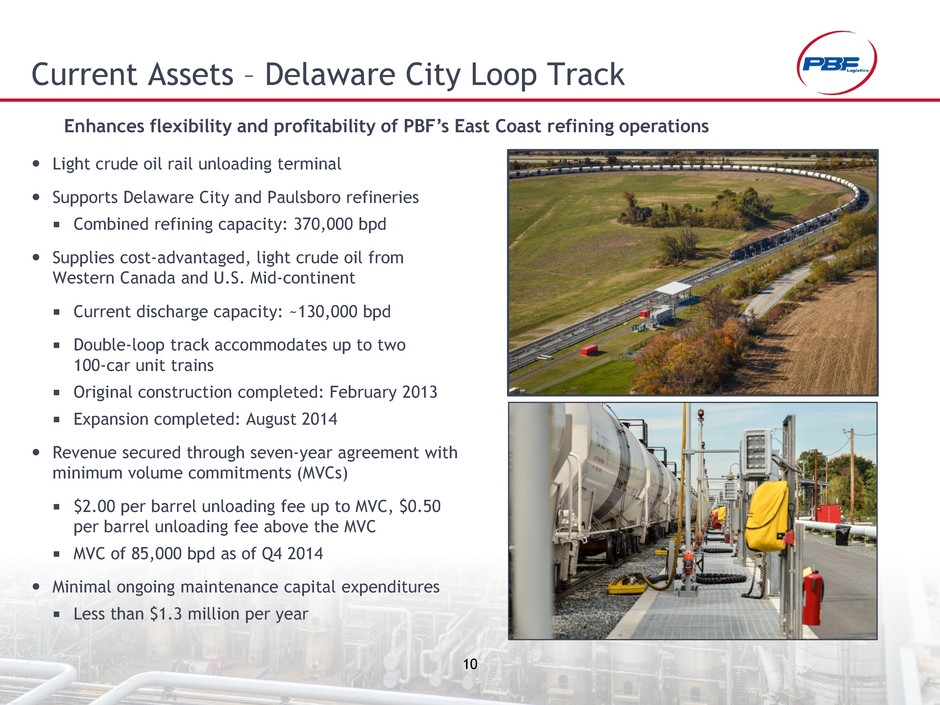
10 Current Assets – Delaware City Loop Track Light crude oil rail unloading terminal Supports Delaware City and Paulsboro refineries Combined refining capacity: 370,000 bpd Supplies cost-advantaged, light crude oil from Western Canada and U.S. Mid-continent Current discharge capacity: ~130,000 bpd Double-loop track accommodates up to two 100-car unit trains Original construction completed: February 2013 Expansion completed: August 2014 Revenue secured through seven-year agreement with minimum volume commitments (MVCs) $2.00 per barrel unloading fee up to MVC, $0.50 per barrel unloading fee above the MVC MVC of 85,000 bpd as of Q4 2014 Minimal ongoing maintenance capital expenditures Less than $1.3 million per year Enhances flexibility and profitability of PBF’s East Coast refining operations
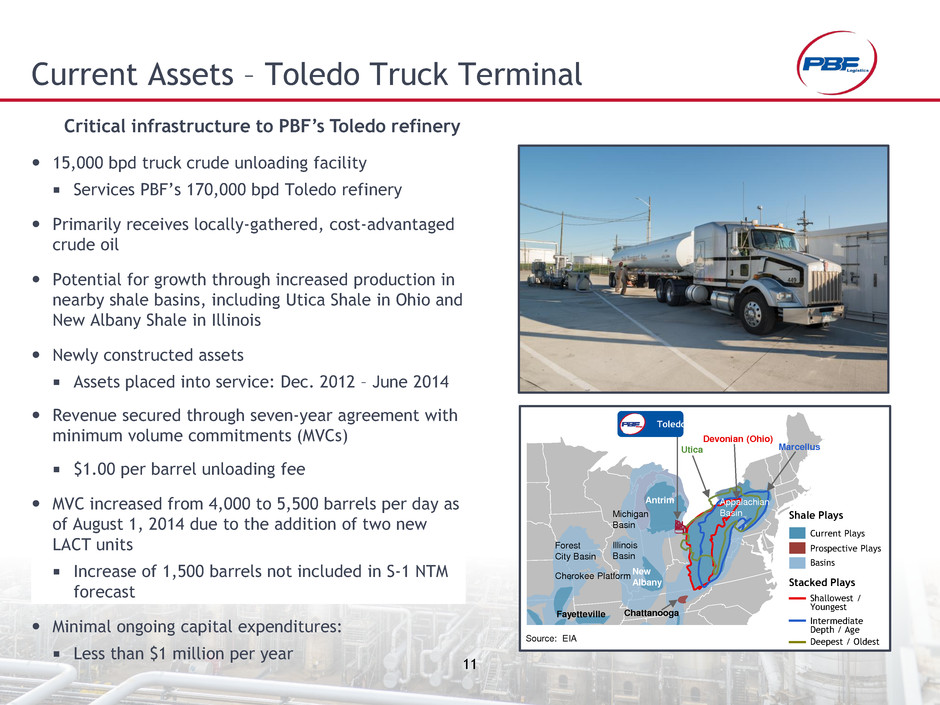
11 Current Assets – Toledo Truck Terminal 15,000 bpd truck crude unloading facility Services PBF’s 170,000 bpd Toledo refinery Primarily receives locally-gathered, cost-advantaged crude oil Potential for growth through increased production in nearby shale basins, including Utica Shale in Ohio and New Albany Shale in Illinois Newly constructed assets Assets placed into service: Dec. 2012 – June 2014 Revenue secured through seven-year agreement with minimum volume commitments (MVCs) $1.00 per barrel unloading fee MVC increased from 4,000 to 5,500 barrels per day as of August 1, 2014 due to the addition of two new LACT units Increase of 1,500 barrels not included in S-1 NTM forecast Minimal ongoing capital expenditures: Less than $1 million per year Critical infrastructure to PBF’s Toledo refinery Illinois Basin Appalachian Basin New Albany Devonian (Ohio) Marcellus Utica Michigan Basin Antrim Forest City Basin Fayetteville Cherokee Platform Chattanooga Source: EIA Toledo Current Plays Prospective Plays Basins Shale Plays Stacked Plays Intermediate Depth / Age Deepest / Oldest Shallowest / Youngest
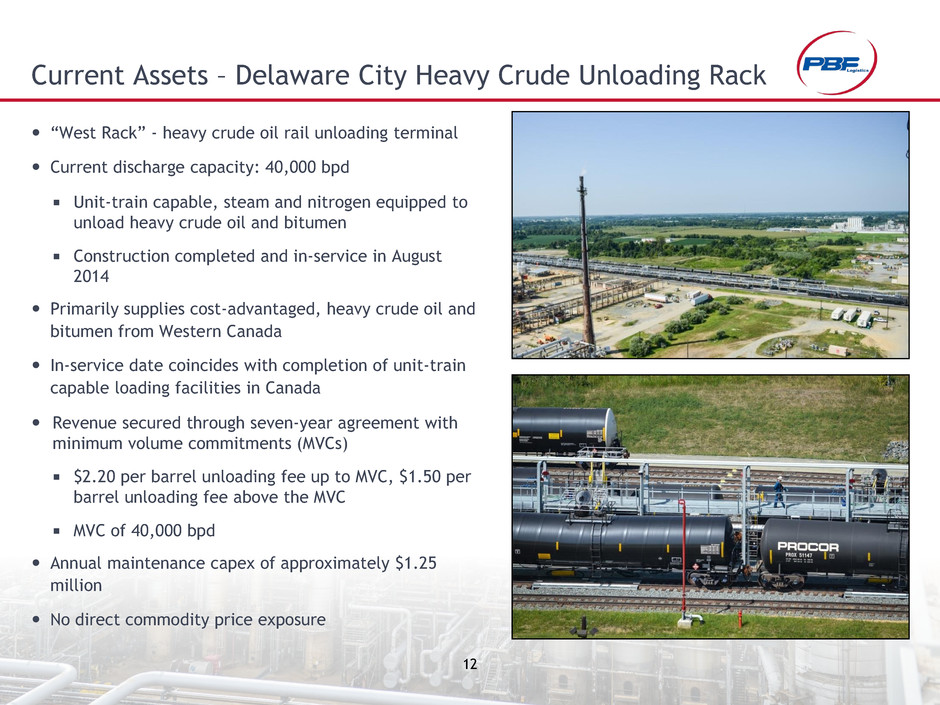
12 Current Assets – Delaware City Heavy Crude Unloading Rack “West Rack” - heavy crude oil rail unloading terminal Current discharge capacity: 40,000 bpd Unit-train capable, steam and nitrogen equipped to unload heavy crude oil and bitumen Construction completed and in-service in August 2014 Primarily supplies cost-advantaged, heavy crude oil and bitumen from Western Canada In-service date coincides with completion of unit-train capable loading facilities in Canada Revenue secured through seven-year agreement with minimum volume commitments (MVCs) $2.20 per barrel unloading fee up to MVC, $1.50 per barrel unloading fee above the MVC MVC of 40,000 bpd Annual maintenance capex of approximately $1.25 million No direct commodity price exposure

13 Tank Farm #2 serves the Toledo refinery’s operations and product distribution activities Activities include: Crude oil and product storage Propane truck loading 30 tanks with total shell capacity of ~3.9 million barrels Crude – 7 tanks with ~1.3 million barrels of capacity Includes recently commissioned ~450,000 barrel crude storage tank Products – 23 tanks with ~2.6 million barrels of capacity Includes ~17.5 thousand barrels of propane storage capacity Current Assets – Toledo Tank Farm #2(1) Revenue secured through ten-year agreement with minimum volume commitments (MVCs) $0.50 per barrel of available shell capacity $2.52 per barrel for propane storage and throughput MVC of 4,400 barrels per day Annual maintenance capital expenditures of ~$3.0 million (1) Toledo Tank Farm #2 drop-down transaction is expected to close on or about 12/12/14
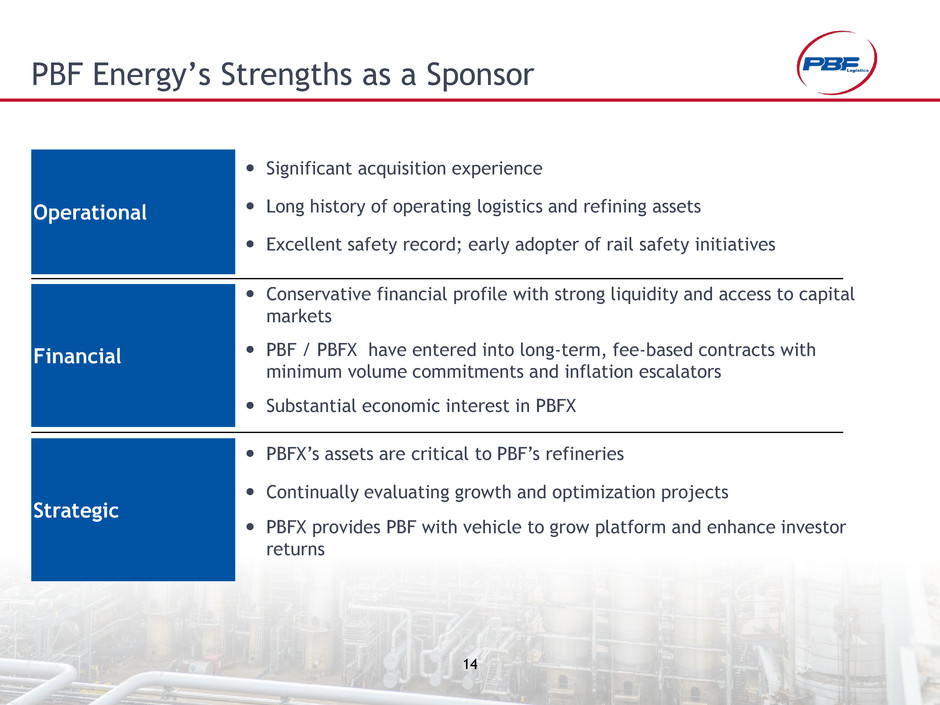
14 PBF Energy’s Strengths as a Sponsor Financial Conservative financial profile with strong liquidity and access to capital markets PBF / PBFX have entered into long-term, fee-based contracts with minimum volume commitments and inflation escalators Substantial economic interest in PBFX Operational Significant acquisition experience Long history of operating logistics and refining assets Excellent safety record; early adopter of rail safety initiatives Strategic PBFX’s assets are critical to PBF’s refineries Continually evaluating growth and optimization projects PBFX provides PBF with vehicle to grow platform and enhance investor returns

15 Robust Drop-down Inventory Retained at PBF Significant growth potential through future drop- downs Critical logistics infrastructure retained by PBF at all three refineries Traditional midstream assets East Coast Storage Facilities 10.0 million bbls at Delaware City 7.5 million bbls at Paulsboro Multiple marine terminals Adds future export optionality Refined products pipeline and heavy crude oil terminal Additional truck racks, rail terminals and LPG loading/unloading facilities PBFX has ROFO on substantial portfolio of logistics assets retained at PBF

16 PBFX Business Strategies Grow through acquisitions Pursue organic growth initiatives Maintain safe, reliable and efficient operations PBFX has ROFO on PBF’s extensive portfolio of traditional logistics assets PBFX and PBF can pursue strategic acquisitions, either independently or jointly Generate stable, fee- based cash flow Utilize long-term, fee-based contracts with minimum volume commitments and inflation escalators Maintain no direct exposure to commodity price fluctuations Conservative total unit distribution coverage target of 1.15x Pursue organic and optimization projects that complement and expand existing asset base Expanded Delaware City Rail Terminal capacity from 105,000 bpd to 130,000 bpd Increased MVC by 10,000 bpd beginning in Q4 2014 Expanded Toledo Truck rack from 4 to 6 LACT Units Increased MVC to 5,500 bpd beginning August 1, 2014 Committed to maintaining and improving safety, reliability, environmental compliance and efficiency of operations

17 Increasing Stakeholder Value Operate safely and efficiently Maintain capital discipline and conservative balance sheets Invest in revenue improvement projects Grow through strategic acquisitions Return cash to investors
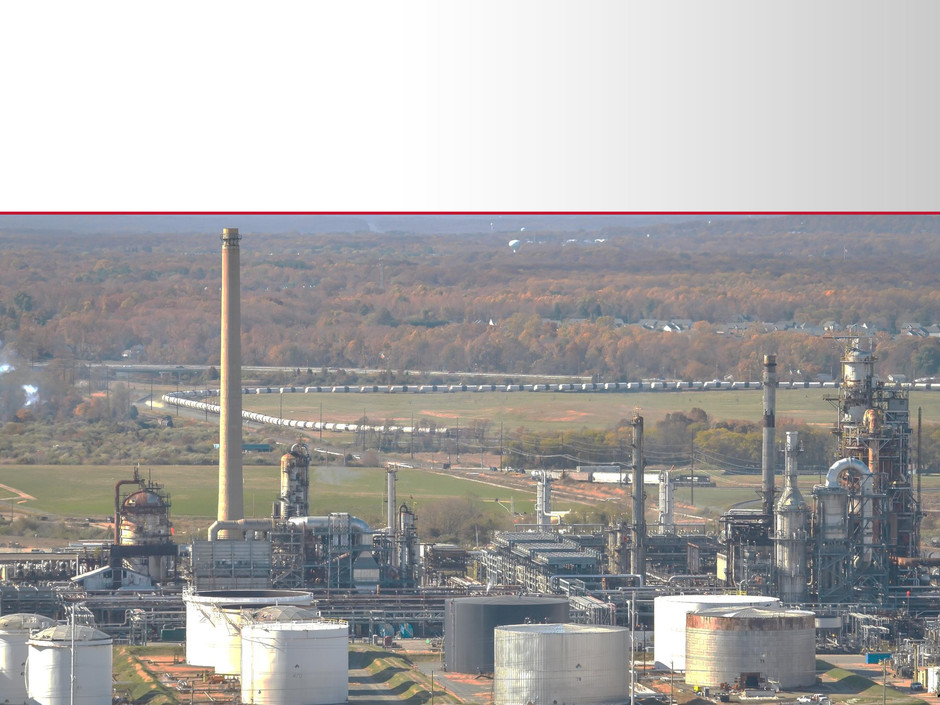
1 8

















